Shade - The "Good" Stuff
Learn about plants that can be used in shade gardens.
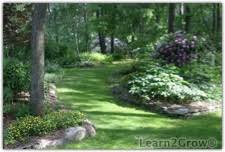 This article completes our series on shade gardening, at least for now. We have covered the basics of shade gardening, strategies for dealing with the worst shade conditions and plants and strategies for mediocre shade. This time we are covering "good" shade conditions and the wide array of plant that will thrive in shade. The earlier articles covered some of the shade plants that can tolerate tougher shade conditions, you can learn about plants for more difficult shade conditions by referencing the articles above.
This article completes our series on shade gardening, at least for now. We have covered the basics of shade gardening, strategies for dealing with the worst shade conditions and plants and strategies for mediocre shade. This time we are covering "good" shade conditions and the wide array of plant that will thrive in shade. The earlier articles covered some of the shade plants that can tolerate tougher shade conditions, you can learn about plants for more difficult shade conditions by referencing the articles above.
The great news about "good" shade is that this kind of shade gardening is just as easy as sun gardening. We previously defined "good" shade as areas that get morning and/or late afternoon sun, receive dappled shade all day and areas that are bright, but not sunny. Tree roots or dark spots don't complicate this type of shade; this means that you have all of the various shade plants to play with. To quote my favorite baseball announcer, Jack Buck, "Go crazy folks! Go crazy!" I unfortunately do not get to play with "good" shade in my garden. I have wonderful light, but deep tree roots do limit my plant selection. My mom, on the other hand, can tap into any shade plant out there. She also has gorgeous light from shade trees, but the raised beds are around her porch rather than actually under the trees - perfect conditions for shade plants.
Some of the plants that will take less ideal shade conditions are English Ivy Hedera, Liriope, Ajuga, Ferns, Brunnera, Lily-of-the-Valley(Convallaria), Hosta, Heuchera, Helleborus, Astilbe, Dicentra, and Impatiens. All of the plants that will do well in tougher shade conditions, will thrive in the best shade conditions.
The most common shade annual categories are probably Impatiens, Torenia, Begonia, Coleus and Fuchsia. I have covered all of these, except Fuchsia previously. Fuchsia is a great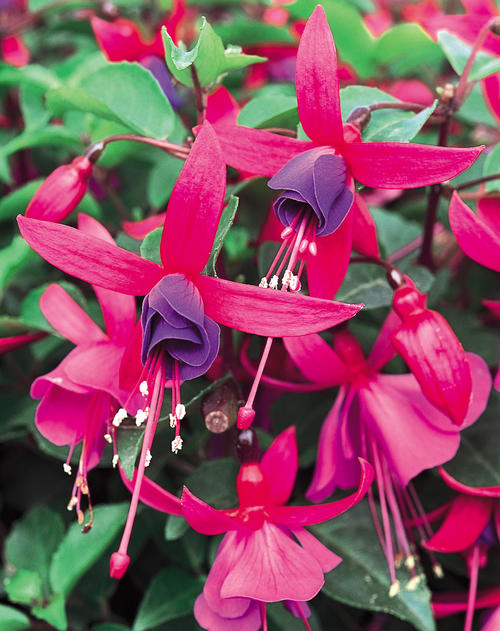 shade plant. Many of us may think of them mainly for use in containers, but they can be planted in the landscape as well. Fuchsias come in a range of colors. The flowers are single to double. In addition to the standard Fuchsia, there are several other species available that are larger more landscape types of plants. If you live in an area with mild winters (zones 7-9), Hardy Fuchsia (Fuchsia genii) are a good perennial landscape option for shade.
shade plant. Many of us may think of them mainly for use in containers, but they can be planted in the landscape as well. Fuchsias come in a range of colors. The flowers are single to double. In addition to the standard Fuchsia, there are several other species available that are larger more landscape types of plants. If you live in an area with mild winters (zones 7-9), Hardy Fuchsia (Fuchsia genii) are a good perennial landscape option for shade.
Perennials are where you can really start to have a lot of fun with "good" shade conditions. Here are some plants to consider:
Aruncus, Goat's Beard, has fern-like foliage and will bloom from early to mid-summer with feathery, spikes of white blossoms. Yellow to orange foliage gives it a second season of color for the garden.
Cimicifuga, is a native plant that is hardy in zones 4-8. It likes consistently moist soil and can take several years to establish well in the garden. However, it is worth the time. Look for black foliaged varieties. It is a larger plant, up to 4 feet and blooms late in the season.
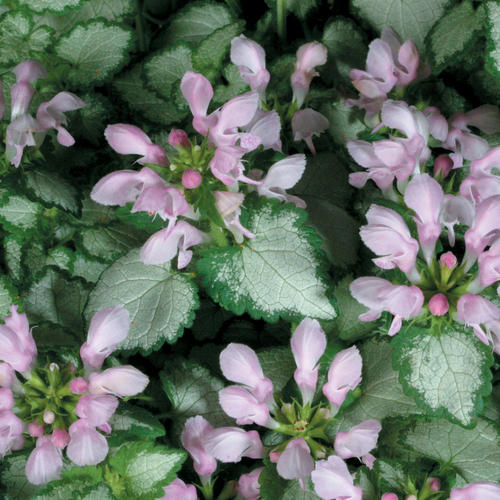 Lamium, (photo left) Spotted Dead-Nettle, generally has green and silver variegated foliage and pink or white flowers. However, it does come with gold and green foliage as well. It is hardy to zone 3.
Lamium, (photo left) Spotted Dead-Nettle, generally has green and silver variegated foliage and pink or white flowers. However, it does come with gold and green foliage as well. It is hardy to zone 3.
Ligularia, is very cold tolerant. It is usually hardy to zone 4, with some versions hardy to zone 3 and others only hardy to zone 6. Be sure to check the plant tag before buying to be certain of the specific hardiness. This is another plant that must have moist soils, do not allow soil to dry. Often one of the larger plants available for shade gardens, up to 5 feet, more compact forms that are appropriate for smaller gardens are also available. The large, serrated leaves are interesting even before the spikes of yellow flowers appear in mid-summer.
Polygonatum 'Variegatum', Variegated Soloman's Seal, is a classic shade plant. Grown mostly for it's variegated foliage it does have pendulous white blooms. It is hardy to zones 3.
Tricyrtis, Toad-Lily, is one of the few members of the Lily family to prefer shade. They tend to be late to emerge in spring, so don't worry if you don't see them when the rest of your perennials start to appear. Have patience, they like to take their time. Their biggest attraction is their orchid-like flowers. Because the flowers are so unique, you might want to place the plants near seating areas or along pathways where they can be admired up-close. They do prefer consistently moist conditions. They are generally hardy to zone 5, but can be as hardy as zone 4 or only hardy to zone 6, check the plant tag or online sources for variety specific information.
It is often easy to think of plants for your garden bed as being restricted to annuals and perennials, but that would be a huge disservice to the shrubs that can add another dimension to both shade and sun plantings. Incorporating shrubs into your planting beds is one of the best ways to integrate shrubs more seemlessly into your garden. In a previous article we mentioned Dream Catcher™ Kolkwitzia, Hibiscus syriacus and Celtic Pride™ Microbiota. Here are some additional shrubs that will work in "good" shade conditions.
Abelia, (photo right) will do well in part shade gardens, but not full shade. They are generally hardy to zone 6, but some may survive in zone 5. Newer cultivars, such as those in our collection, are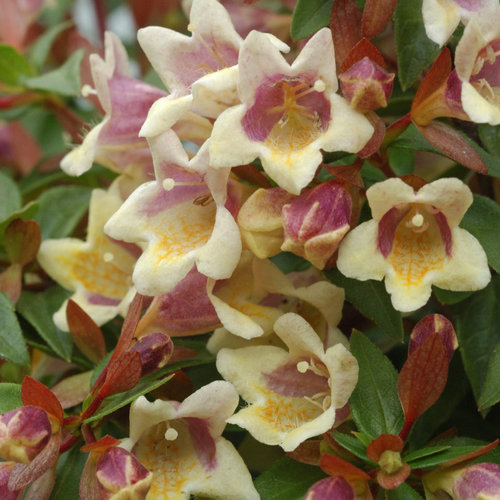 compact enough to work in smaller gardens and usually feature several seasons of color including spring flowers and fall foliage color. Abelia is also not a favorite of deer
compact enough to work in smaller gardens and usually feature several seasons of color including spring flowers and fall foliage color. Abelia is also not a favorite of deer
Amelanchier, Serviceberry, is a group of shrubs and small trees that are native to many parts of the U.S. and Canada. They bloom in early spring and then form fruits that are a good food source for wildlife. Fall color adds to their appeal. They are generally hardy to zone 4.
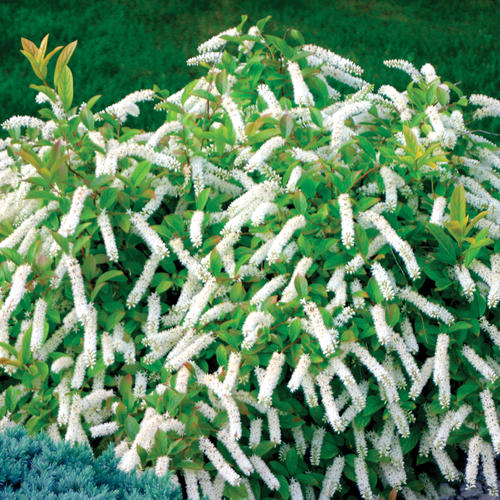 Itea, is a useful native plant with lots of potential for the home landscape. It prefers moist soils and will tolerate wet conditions. It will grow in full sun to full shade, and requires little pruning or other maintenance. The variety Little Henry® has lightly scented, pure white flowers that shoot like fireworks in early summer. Its mounded, compact stature makes it an improvement over older varieties. Maturing at less than 3 feet tall, it is suitable for flooding large banks with mass plantings. It is also a delightful addition to the mixed border. Then when you're not expecting anything more from this little wonder, its green summer foliage changes to a brilliant multitude of oranges and reds in the fall, making Little Henry® a rewarding experience through out all seasons. It is hardy in zones 5-9.
Itea, is a useful native plant with lots of potential for the home landscape. It prefers moist soils and will tolerate wet conditions. It will grow in full sun to full shade, and requires little pruning or other maintenance. The variety Little Henry® has lightly scented, pure white flowers that shoot like fireworks in early summer. Its mounded, compact stature makes it an improvement over older varieties. Maturing at less than 3 feet tall, it is suitable for flooding large banks with mass plantings. It is also a delightful addition to the mixed border. Then when you're not expecting anything more from this little wonder, its green summer foliage changes to a brilliant multitude of oranges and reds in the fall, making Little Henry® a rewarding experience through out all seasons. It is hardy in zones 5-9.
Rhododendrons and Azaleas can be confusing, but one thing we know for sure is they are one of the showiest classes of shrubs for shade conditions. You, like me (before I dug into the research for this article), might be confused as to what the difference is between an Azalea and a Rhododendron. Well, in the words of the New York Chapter of the American Rhododendron Society, "all Azaleas are Rhododendrons, but not all Rhododendrons are azaleas." At one time, Azalea and Rhododendron were two separate genera, but they are now all considered to be Rhododendrons. The best rule is that Azaleas are mostly deciduous, while Rhododendrons are usually evergreen. This general rule won't always be right, but it will be right much more often than it is wrong. However, the most important thing, whether we are talking about an Azalea or a Rhododendron, is that both types of plants are very showy shade garden plants.
The hardiness for Rhododendrons will vary considerably. Some will be hardy to zone 3, while others are only hardy to zone 7. Make sure you are selecting a plant that is hardy for your conditions. Plant breeders have put forth a lot of effort to select more hardy plants for this genus and we get to benefit from their decades of effort. This article, from University of Minnesota Cooperative Extension, is a good rundown of the hardiest Rhododendrons including Azaleas.
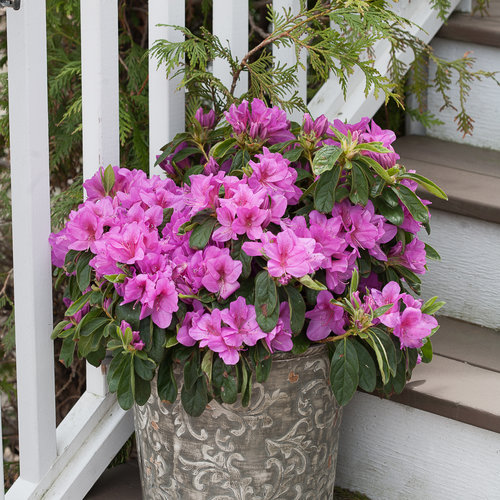 One of the newer developments in Azalea is plants that will not only put on a show in spring, but will rebloom. The Bloom-A-Thon® series, like other azaleas, will bloom in spring and this flowering period will last several weeks. Once the spring flowers fade, the plant takes a brief rest and by early July, is gearing back up for its summer flowering. The breeder says that it is actually this July-August period that is their true shining moment, and that the display is even more spectacular than the spring one. After the summer bloom, the plant doesn’t take the same rest again, but continues to put out flowers until mid-November, when cold weather has really set in and the days are considerably shorter. They are hardy in zones 7-9 and come in 4 colors.
One of the newer developments in Azalea is plants that will not only put on a show in spring, but will rebloom. The Bloom-A-Thon® series, like other azaleas, will bloom in spring and this flowering period will last several weeks. Once the spring flowers fade, the plant takes a brief rest and by early July, is gearing back up for its summer flowering. The breeder says that it is actually this July-August period that is their true shining moment, and that the display is even more spectacular than the spring one. After the summer bloom, the plant doesn’t take the same rest again, but continues to put out flowers until mid-November, when cold weather has really set in and the days are considerably shorter. They are hardy in zones 7-9 and come in 4 colors.
There are certainly other shade plants available, but this should give you a good starting point.
Patent Info:
Little Henry® Itea virginica'Sprich' PP: 10988; Gaelic® Spring Pulmonaria 'Irish Spring' PP: 14015




